
1933 History
of the Eloise Butler Wildflower Garden
1933 was a year of momentous change for the Wild Flower Garden. Its' founder would pass away and be replaced by someone she knew - Martha Crone. Martha recalled that she had spent about 15 years helping out in the Garden. She and her husband William, a dentist, lived at 3723 Lyndale Ave. North in Minneapolis. Together, they were avid explorers of plant habitat and especially mushroom habitat.

Martha was secretary of the Minnesota Mycological Society from 1926 to 1943. Considering the need for large numbers of plants for the developing Wildflower Garden, the Crones were able to provide good assistance to Eloise Butler in finding sources for wild plants and for rescuing plants from areas where the native habitat was soon to be overrun with development.
The winter of 1932/33 was all weather and politics. A warmer than average January was followed by a deep cold snap in February. Eloise spent the winter on the East Coast with relatives, as she had since 1911. She would return to a cold late-March but with most snow gone.
Eloise Butler's last letter to Martha Crone.
Eloise wrote to Martha and Bill Crone on January 11 from Malden, thanking them for the Christmas gift they sent. (pdf copy) She discussed some of her other gifts, the weather and her health. There in no indication she is feeling ill or has any other issues. Eloise had also been in contact with a Mrs. Pearl Frazer in regards the position of Curator at the Garden. She enclosed a copy of a letter from Mrs. Frazer and asks Martha to keep it until she returned when they can discuss the Garden and maybe show the letter to Theodore Wirth. It turned out that Mrs. Frazer was not actually interested in a curators position but something else.
Eloise wrote on January 11: “I want also to thank you especially, Mrs. Crone, for what you wrote about the continuance of the wild garden. There’s too much of truth in what you say, but I will soon be able to talk with you about the matter in detail. In this time of depression nothing can be done except to hang on by the skin of one’s teeth. And what, if there hain’t no skin?”
We do not have a copy of Martha's letter to Eloise that Eloise refers to but it evidently concerned the dire straits of Park Board budgets in the Great Depression and what effect that would have on the Garden. This is probably the last correspondence between the two and there is no indication in Martha Crone's diary that she ever saw Eloise prior to Eloise's death on April 10. She only notes in her diary on April 11 that she heard from Clara Leavitt about Eloise.
This would be FDR’s first term as president and the beginning of the New Deal.
Martha Crone wrote in her diary: (1)
March 2, Thursday “looking forward to Inauguration of Pres. with great hope, everyone excited, expecting him to perform miracles.” weather still lovely.
March 4, Saturday “Inauguration of Franklin Roosevelt. Radio going all day. Took in parade. Pres in bullet proof case after threatened assassination. All banks in U.S. closed, great excitement.”
A local photographer, Mr. E. F. Pabody, was in the Garden area on March 25th and took these three winter scenes, following a snowfall of 2+ inches. Mr. Pabody had his studio at 1920 Colfax Ave. So., Minneapolis, and frequented the Garden.
Photo titles:
Photo above: "Looking across the little pool near lower gate"
1st photo below: "Path through the tamaracks"
2nd photo below: "Looks like spring in the air."


When she left Malden on March 31, Eloise had been unsuccessful in her endeavor of the last few years to find a successor. She returned to her Minneapolis lodgings at the J. W. Babcock house (located just east of the Garden at 227 Xerxes Ave. No.) on April 3 1933. As he usually did, Mr. Babcock notified her Garden helper Lloyd Teeuwen, that she had returned but Eloise wanted to rest a few days after the long train ride from the east coast as she was “not used to walking a lot yet.”
Several days later Lloyd came to the house and carted down to the Garden office the assortment of books from her library at Babcocks that she wanted in the Garden and also the Garden’s tools which were kept in the Babcock carriage house over the winter. Then they took the first walk of the year through the Garden where Eloise inspected all the areas to see what was what. She walked very slowly so Lloyd kept behind her to not outrun her. Eloise remarked how enthusiastic she was to be back outside where she could do something because in Boston nobody wanted to do anything.
The only work she noted in her Garden Log was planting Swamp Candles Lysimachia terrestris on April 8 on the north side of the Mallard Pool. These had been heeled in during the winter. (2)
On the wet morning of April 10, 1933 she attempted to reach the Garden from the house . She apparently suffered a heart attack and got back to Babcocks. A doctor was summoned but nothing could be done and she soon passed away on the couch in the entryway of the house at 3:15 PM. Her funeral was on April 12th, 12:45 PM at the Lakewood Chapel. On May 5th, her ashes were scattered in the Garden (around the little office) as had been her wish. The details of her death, including the long-held mis-belief that she died in the Garden, are covered in our short history of her life. The Minneapolis Journal printed a front page notice of her passing. (PDF)
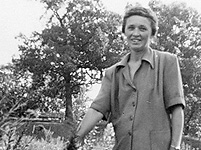
The Garden was closed until April 20th. During that time the Park Board had to find a person to attend to the Garden. Martha Crone, although highly recommended, had not originally been a shoo-in for the job as Eloise had corresponded with Mrs. Frazer about the job, but she was looking for somewhat different work (3) (and see notes in Winter section). With Eloise now gone, Martha Crone met with Parks Superintendent Theodore Wirth at his office on April 13. (1). On the 18th Theodore Wirth wrote to the Board of Park Commissioners that he had appointed Martha temporary Curator during the balance of the season or such other time thereof as seems advisable and satisfactory, from date to October 1, 1933 at a salary of $60 per month. [The position would remain temporary until 1940.] The board approved the appointment on the 19th.(4) On the 19th her husband Bill received a call from Wirth for Martha to be at the Garden the next day, where she met with Wirth, Wirth’s assistant C. A. Bossen, Mr. Babcock (Eloise's Landlord who would see that possessions belong to Eloise were sent back to Malden) and Mr. Erickson (Carl - park keeper for Glenwood Park). She opened the office and she and Miss Merkert, Wirth’s secretary, began taking inventory. (1) There is a copy of that inventory in the records of the Martha Crone Collection at the Minnesota Historical Society.
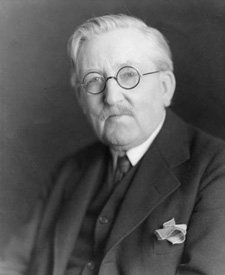
On April 21, a Saturday, Martha was in the Garden in the morning, and went home at noon. During these first days of her tenure the Garden was not open for a set time as she arranged her affairs so that she could be there as required - every day, except Wednesday, till 5 PM - April 1 through September 30. (1)
On the 23rd Martha noted that there was a steady stream of visitors all day (all the newspapers had reported the death of Eloise Butler) and that there were many fires near the Garden and at 6 PM there was a fire on the west boundary of the Garden and Martha fought 1-1/2 hours to put it out. Dr. Thomas S. Roberts had visited that same day and again on the 30th. (1)
On the 29th someone brought in the knarl of a red elm. It was “planned to saw it through the center making two tables for the Garden in memory of Miss Butler.”
Back on April 19, Theodore Wirth had sent a letter to the Park Commissioners notifying them of the death of Eloise Butler, a little about her history, and set May 5, Arbor Day, as the date for a remembrance ceremony at the Garden and also got the ball rolling on the commemorative tablet that was placed one year later. These details were also reported in the newspaper. (4) It is not unusual that the accomplishments of an individual are more clearly understood after that person has passed on. While certain people are "in-the-know" about what an individual is accomplishing, it is only after death, when congratulations are too late that the rest of world becomes aware of the qualities of the individual whose life is now past. Theodore Wirth was probably the first to craft a brief but informative statement about the role Eloise Butler had taken on and played with such accomplishment.
On the 28th he followed up with a memorandum detailing the events of May 5th. (memorandum).
The commemorative tablet that Wirth mentioned on April 19 was reported again in the newspaper in an article announcing the upcoming ceremony. The Minneapolis Tribune stated on May 4 "Near the little cabin that served as her office the commissioners will stand about and scatter her ashes among the flowers she loved. They will plant a young oak in her memory, knowing that before long her former botany students will have subscribed enough for a bronze tablet to commemorate the occasion and to perpetuate her name.” The article reported that the commissioners visited the Garden on Wednesday afternoon of May 3. [Perhaps it was the first time for many.] "They inspected the growths, the cabin, paused at the bird bath of stone, noted the bird houses, and agreed that the wildflower garden was a place of serene and peaceful beauty."
That same day Martha sent her letter of acceptance of the position to Wirth. Workmen were in on the 4th, bringing a Pin Oak and a small Honey Locust which were set in the ground but not covered. (1)
Below: Two newspaper photos of Park Board members visiting the Garden on May 3, 1933. Left: At the 1917 Stone birdbath in the Garden - (l to r) Alfred F. Pillsbury, president; Lucien C. Miller and Francis A. Gross. Right: At the entrance to the Garden is Superintendent of operations and maintenance of the Park Board Christian A. Bossen. Both Minneapolis Tribune photos.
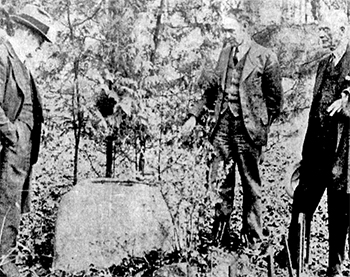
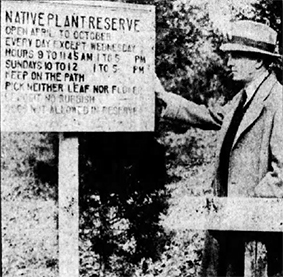
Above: The entrance sign to the Garden reads: Native Plant Reserve -
Open April to October -
Every Day except Wednesday -
Hours 9 to 11:45 AM 1 to 5 PM -
Sundays 10 to 12 1 to 5 PM -
Keep on the path -
Pick neither leaf nor flower -
Deposit no rubbish -
Dogs not allowed in Reserve.
The sign had never been updated for the change of Garden name in 1929 to the Eloise Butler Wild Flower Garden.
On May 5th a tire was stolen from the Crone’s car and Martha arrived a bit stressed. She received her first paycheck ($22) that day. Superintendent Wirth was in the Garden all morning, and at 4PM the Board of Park Commissioners and about 100 friends of Eloise Butler gathered at the Garden for the remembrance ceremony. (1)
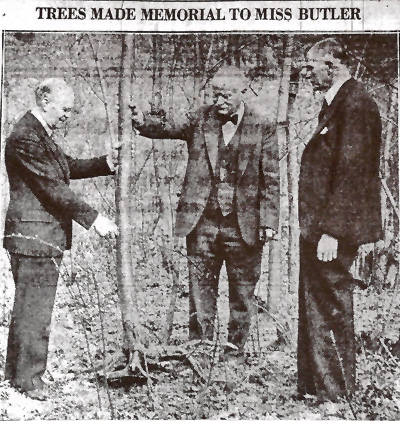
Above: Finalizing the planting of the Pin Oak: (l to r) Alfred F. Pillsbury, President of the Board of Park Commissioners; Theodore Wirth, Superintendent of Parks; Francis A. Gross, Vice President of the Board.
Park Board President A. F. Pillsbury opened the ceremony with these words:
“We have gathered here today to do honor to one who was the moving spirit in the establishment and care of this unique and interesting garden. Being a great lover of nature, an especially of wild flowers and plant life, it was her desire that one part of our park system should be left in its natural condition and devoted to the wild flowers and birds of our state. Under her loving care for many years, this garden has become famous and given pleasure to many. In the presence of friends and to her memory we have planted this rare tree, and in accordance with her wishes we now, with respect and admiration, distribute the ashes of Miss Eloise Butler over the ground she loved so well.”
President Pillsbury was then given by Martha Crone, a cardboard box holding the ashes of Miss Butler and he then began to spread the ashes first around the base of the tree and then in the area on all sides of the little office building. Some of the ash was wafted farther by the breeze. The audience looked on in silence. The only sound was that of Mr. Pillsbury moving through the growths.

Martha Crone and Theodore Wirth spoke last. Martha Crone read Eloise Butler's last report to the Park Board. General Superintendent Wirth in a few brief remarks called attention to the fact that the pin oak had long been a favorite of Miss Butler’s and for this reason had been chosen as the tree to be dedicated in her services. He suggested that a year from today this same group of friends gather to place a bronze tablet on a boulder near the tree to perpetuate the dedication, and those friends then made preparation to raise the funds necessary for this purpose.
In the days following the ceremony Martha took care of Garden duties, planting the seeds and plants that had accumulated from Eloise Butlers previous arrangements. The Garden looked good - on May 14 she noted “Mobs at garden in afternoon, trilliums beautiful, also mertensia.”(1)
On the 15th Mrs. Cram (Gertrude Cram) was in, then Mrs. Phelps and Miss Leavitt - all friends of Eloise Butler. All three and Martha would be on a committee to provide the script for the memorial tablet for Eloise Butler (PDF of Committee details).
The organization formed was called the Eloise Butler Memorial Association. There were several suggested dedications which were submitted to Martha Crone for her approval and for her to sample the preferences of Garden visitors as to the wording. A fund raising campaign was initiated with the suggested donation being limited to no more than one dollar. The Association felt that they must raise the funds independently so as to "prove to Mr. Wirth and the Park board that the Reserve (The Wild Flower Garden) has many friends." The dedication wording recommended by the committee was approved by Martha and all interested others and the bronze tablet was cast, using the design of a Mr. Melchior of Flour City Iron Works and installed in 1934.
On the 18th Theodore Wirth’s secretary, Miss Merkert was in to sort out the books in the office that had been the domain of Eloise Butler - the books belonging to Eloise were being sent back to the Butler relatives at Malden MA.
May 20 was not a good day - Bill Crone was driving Martha to the Garden when they were in an accident at Lowry and James. Martha sprained an ankle and skinned an elbow but nevertheless arrived at the Garden by 9:15 AM. Due to the dry spring weather there was a dust storm on the 23rd - no Garden visitors. On the 25th Martha closed the Garden at 3 so as to get down to the main Minneapolis Library for a meeting on the memorial for Eloise.

Back on 23rd April Gertrude Cram had send a note of introduction to Martha. Mrs. Cram then ends with this comment about Martha: “She (Eloise) said ‘you really should know her; she is a wild flower crank like you.’ That tells us both what to expect, doesn’t it?” (5)
One of the purposes for plants collected and planted by Martha in 1933 was the completion of the planting around the Mallard Pool area that had been started by Eloise Butler in 1932. (details) In 1932 Eloise Butler’s design for this pool area had been accomplished and she had started the planting from her list of desired plants. Martha’s May and June collecting trips, especially to areas around Anoka were to secure plants needed for the pool area. In that era one could still dig up plants in open areas without much restriction, even on street corners.
Martha was well known in the area for her plant collecting efforts. She did what Eloise had done - search the wild for suitable specimens and get permission to retrieve them if permission was necessary; rescue them when the habitat was about to be destroyed; receive donations of plants from friends; and plant seeds for new plants.
Many school groups toured the Garden in late May to early June. (1) May was a rainy month, June turned dry and historically hot.
The Showy-lady’s-slippers always bring visitors to the Garden when they bloom. Mid-June this year was the peak bloom time, although it was 95 degrees on June 17. Many June days were over 100 degrees. June 30 was the 14th day of June over 90 degrees. It was the warmest June in weather history (as of 2020) and very little rain. July and August were very dry also.
Mosquitos were always a problem in the Garden. So bad in early 1933 that Theodore Wirth complained about them to Martha in a letter to her. In her reply (pdf copy) dated June 22 she wrote: “I wish to offer my apologies for the ill manner of my mosquitoes, they are rather difficult to train as each one lives only a short time.” (letter).
Martha’s husband Bill frequently came to the Garden with her on Sundays and on July 2nd he cut a new path in the meadow to reach the new Mallard Pool. (1) Eloise wrote in her Mallard Pool essay that she had a plank walk installed at the north end of the pool where the bridge was so we believe the new path approached from the southern end. Martha mentioned her work on the paths in the Garden in her annual report to the Superintendent. (6)
On July 13, Gertrude Cram came to the Garden with a Mr. Burgess who was a frequent Garden visitor and occasional plant supplier.(1) The water fountain inside the Garden front gate is a memorial to him and his wife, Louise.
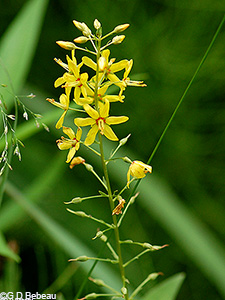
Martha applied to Theodore Wirth on July 15 for a 5 day vacation. Time off was granted and it was taken on July 26 to 30. She was on a plant collecting trip to Duluth and the North Shore and noted in her diary on the 31st - “planted many plants we brought from Duluth.” On July 31 and August 1, her log shows 304 plants put in representing 33 species. (2)
This group of plants was supplemented with packages of plants shipped by Mrs. Cram from Isle Royal where she was vacationing in August. She had done this for some years for Eloise Butler and it would continue until 1939. Humorous letters would accompany the plants. Here is an example from a letter posted from Isle Royal August 8, 1933 - Mrs. Cram writes:
“By the Wednesday boat I am sending you a box of things, a funny one. It contains a sample of a number of plants of which you may or may not want more. ... This is what Miss Butler used to call a ‘surprise’ package, I am sure. The tall yellow things on top of the box is (sic), I think, Lysimachia terrestis, (Swamp Candles) which Miss Butler asked for last year. The roots go to China. I don’t think I got much, for as I was groveling in the muck among sticks and roots I couldn’t seem to feel the ends of the ones I was blindly following.”
Theodore Wirth would visit the Garden several times during the summer months - perhaps to check on how his new curator was doing.

On Aug. 28 Martha and husband Bill gathered cranberries in the Quaking Bog to go into a collection of fruits of the Garden. It is unclear from the diary if this was for the Garden Office or for a State Fair display. She also was gathering mushrooms for the Mycological Societies State Fair exhibit. On September 4 she noted picking up a 15 pound Frondosa and many others out of the Garden for the fair exhibit. (1) 1933 was unusual in that no morel mushrooms were found that year.
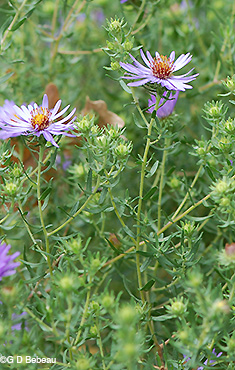
On September 14 at 11:45 at the bath house at Glenwood Lake (now Wirth Beach) she meet Mr. Boeglin (Louis - in charge of forestry and horticulture for the Park Board), 3 men and a truck from the Park Board and they went to Rice Lake at Shakopee to get Lotus. (1) She reported they got 125 good roots and they were back at 5 PM. This was probably to fulfill a request of Theodore Wirth to locate the plants, a request that she referenced in her June 22 reply to his letter (noted above in the Summer section). Rice Lake was the place where Martha and Bill discovered an unknown growth of American Lotus in 1930. Details of that are in the 1930 history. She also picked a few other plants and she noted in the log that they came from Rice Lake. This area must have good for collecting because she noted on September 20, a Wednesday - her day off - that she went back to Shakopee and dug Aromatic Aster, Smooth Aster and Ironweed. (1) These she planted on the 21st (2).
On September 19 the Tribune reported that the plans for the Butler Memorial Tablet were in motion with the establishment of a committee and a fund to raise $200 by November 1. (4)
The Garden closed on the last day of September and Martha noted that Mr. Johnson (Ben) came to the Garden to get Garden books, etc, for winter storage. Martha and Bill would frequently return to the Garden after closing in those early years to attend to the birds, helping out with the work of Miss Lulu May Aler.(7) Thus on October 20 she wrote: “went down in garden to meet Miss Aler and Mrs. Ure at 1:30 put up bird pan and filled bird bath, real cold but sat in office for awhile.” (1) To the Garden again on the 25th where they saw many birds including a wood cock, and she collected seed of Red Turtlehead. (1)
In her first annual report to the Parks Superintendent (6) Martha Wrote: "It is indeed an effort well repaid to visit this beautiful spot where the abundance of our native flora has been made still more beautiful and interesting by plantings of other Minnesota wild flowers that are fast becoming exterminated elsewhere. During the season many varieties of seeds were sown. 1330 plants were set out, all obtained from their native haunts. They comprise 166 species, representing 108 genera and 48 families.
It has been an honor and a pleasure to have served in the Native Plant Reserve this past season and I wish to thank you for the privilege."
Twenty-seven species were added to the Garden, nine were new and those are listed in her log are listed below.
On November 11 she noted “15th anniversary of the Armistice, very quiet, hardly to be noticed”(1) and on Thanksgiving Day, November 30 “Bill and I to garden to feed birds, warm and rainy.”(1) They go several more times in December, including with Miss Aler on December 10.
A Christmas tree cost the Crones 75 cents in 1933. On Christmas Day it was 16 below in morning and 8 below all day. Coldest Christmas since 1890, following what had been the hottest June in recorded weather history for the area.
October, November and December had very little precipitation. Snowfall and total precipitation for the year were well under average.
List of new species added to the Garden in 1933
- Epilobium molle [now Epilobium strictum] - Downy Willowherb.
- Filipendula ulmaria - Queen of the Meadow
- Fragaria virginiana - Virginia Strawberry
- Ilysanthes gratioloides [now Lindernia dubia - Long-stalked Pimpernel
- Listera cordata - Heartleaf Twayblade
- Lophotocarpus depauperatus [now Sagittaria calycina var. calycina] - Hooded Arrowhead
- Polygala alba - White Milkwort
- Spiranthes latifolia [now Spiranthes lucida] - Shining Lady's Tresses
- Triglochin maritima - Seaside Arrowgrass
Photo top of page is a collage of Eloise Butler at 4 stages in her life: A young woman, ca. 1890, Garden Curator 1910-20, mid 1920s and age 80 at her birthday party, August 2, 1931. Photos courtesy Minneapolis Public Library, Minneapolis Collection, and Minnesota Historical Society.
Specific References:
(1) Martha Crone’s Diary - 1933
(2) Garden Log - 1933
(3) Letter, Eloise Butler to Mrs. Frazer, September 29, 1932. Pearl Frazer was the daughter of Fanny Heath of North Dakota. Mrs. Heath was a wildflower expert and correspondence friend of Eloise Butler. See The Wild Gardener, by Martha Hellander, pgs. 94ff.
(4) Minneapolis Tribune, April 20, 1933. (pdf copy)
(5) Letter of Gertrude Cram to Martha Crone April 23, 1933.
(6). Annual Report to Parks Superintendent Theodore Wirth dated November 19, 1933.
(7) Lulu May Aler - Miss Aler set up and maintained a large bird feeding station at the back side of the Garden, outside the gate, so she would visit several times a week, if not daily, to maintain it. A history of this station and the other work of Miss Lulu May Aler are in this article about Bird Feeding Stations in Wirth Park.
Printable PDF file of this page.
Links to related pages:
- Abbreviated Life of Eloise Butler
- Martha Crone - 2nd Garden Curator
- Ken Avery - 3rd Curator and Gardener
- Cary George - 4th Gardener
- Our Native Plant Reserve - Short document on the origins of the Garden.
- Eloise Butler's writings, a selection of essays written by Eloise Butler on the early Garden years.
- Geography of the Garden- an illustrated tour
General References:
Garden Log - Native Plant Reserve, Glenwood Park, Minneapolis, MN by Eloise Butler
Martha Crone's Garden Log and her 1951 Census of plants in the Garden.
Various papers and correspondence of Eloise Butler in the collection of the Minnesota Historical Society.
Historical Climatology of Minneapolis-St. Paul Area by Charles Fisk.